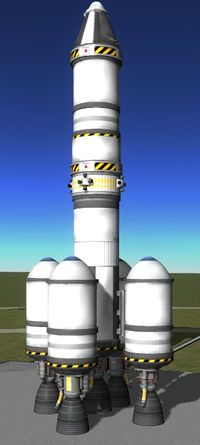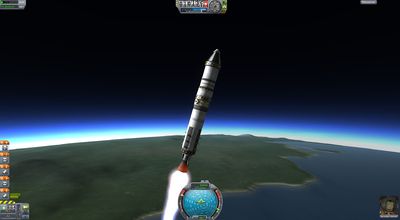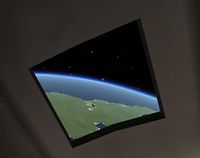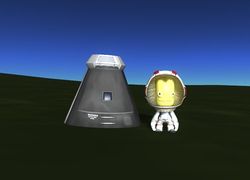Difference between revisions of "Tutorial: Vostok 1"
m (Changed the grammatically incorrect word "kerbins" to "Kerbin's") |
(Changed version number to current version) |
||
| Line 62: | Line 62: | ||
[[File:Vostok-parachute.jpg|200px|Command capsule on parachute]] | [[File:Vostok-parachute.jpg|200px|Command capsule on parachute]] | ||
| − | The real Gagarin didn't actually land with the Vostok 1 - he ejected in the lower atmosphere and landed with a personal parachute. Unfortunately KSP doesn't have personal parachutes (as of 0. | + | The real Gagarin didn't actually land with the Vostok 1 - he ejected in the lower atmosphere and landed with a personal parachute. Unfortunately KSP doesn't have personal parachutes (as of 0.19.1.54), so we are going to land with the capsule. |
Before you activate your parachute, separate the thruster stage - the MK16 parachute can't carry much more weight than the command capsule. Then deploy the parachute. | Before you activate your parachute, separate the thruster stage - the MK16 parachute can't carry much more weight than the command capsule. Then deploy the parachute. | ||
Revision as of 18:11, 16 April 2013
| “ | Orbiting Earth in the spaceship, I saw how beautiful our planet is. People, let us preserve and increase this beauty, not destroy it! — Yuri Gagarin |
” |
After we launched an unmanned satellite into orbit, we will now continue with the next step of space exploration: Bringing a Kerbal into orbit and back to the surface alive.
On April 12, 1961 the spacecraft Vostok 1 started from Russia with Yuri Gagarin on board and carried him around the planet. Gagarin was the first human in history who saw Earth from orbit with his own eyes and experienced weightlessness for longer than a few seconds. After the Sputnik Shock, the first manned spaceflight was another humiliation for the US space program. It lead to the proclamation of John F. Kennedy that he will commit the whole nation to the goal to bring a man to the moon before the end of the decade, because he didn't want to let the Soviets take that victory too.
Contents
[hide]Ship Design
Ironically, the design of a manned craft is even a bit easier than that of an unmanned one, because the crew capsule is self-sustaining. That means we don't have to worry about energy supply like we did for Sputnik. Instead of that we need to add another component to ensure the survival of Yuri Kerbarin: A parachute.
But this time we still have a slightly larger payload. We will also need some extra fuel to de-orbit our vessel and get it back to the ground. We will solve this issue just like the Soviets did: By taking the Sputnik rocket and adding an additional 3rd stage to it.
- Payload stage
- Third stage
- Second stage
- First stage
Note that the monopropellant thrusters and their fuel are still on the second stage. That means they won't be available on the last stage. That's not a problem, though: the capsule itself also has some steering power which is more than enough for control of the light upper stage.
Also note that the upper stage isn't using the LV-T30 engine but the much lighter and energy-efficient LV-909. It won't be used before leaving the atmosphere, and in that phase it's much better to have less powerful but more economical thrust.
Mission Phases
Launch
The launch goes just like that of Sputnik. Launch upwards, dump the first stage, ignite the second and steer to 70°. The difference to the previous mission is that we completely burn the second stage to raise our apoapsis.
Before we reach the apoapsis (the LV-909 engine accelerates slower, so start accelerating before you reach it), we start the prograde thrust of the last stage to enter a circular orbit. Watch out that you don't burn all your fuel, because you still need some left to get back into the atmosphere.
Orbiting
To experience the flight from the perspective of Yuri, click on his portrait and select "IVA" (Intra-Vehicular Activity). This allows you to look out of the small window above him and take a look at Kerbin no Kerbal has ever taken before. Should you see only stars, rotate your craft accordingly (you can do so from the IVA perspective). Should you see only black, you likely are on the night side. Accelerate time until sunrise.
Re-Entry
After Yuri had his fun in orbit, it's time to bring him back home so he can shake hands with politicians, get his parade, write books and go to talk shows. To do so, wait until you are at the apoapsis of your orbit and accelerate retrograde until the trajectory points onto Kerbin's surface. Keep in mind that it doesn't take atmospheric drag into account, so your actual landing will be not as far as the trajectory indicates. Keep this in mind when you intend to land on ground.
When you enter the atmosphere, you will notice a dangerous-looking orange glow around the capsule due to atmospheric reentry heat. But don't worry: as of writing (0.19) this effect is purely visual and can not actually damage your vehicles (with the exception of extended solar panels). In later versions you will likely have to avoid going down too steep, or you will burn up in the atmosphere.
Landing
The real Gagarin didn't actually land with the Vostok 1 - he ejected in the lower atmosphere and landed with a personal parachute. Unfortunately KSP doesn't have personal parachutes (as of 0.19.1.54), so we are going to land with the capsule.
Before you activate your parachute, separate the thruster stage - the MK16 parachute can't carry much more weight than the command capsule. Then deploy the parachute.
There isn't really anything you can do wrong here. When you are in the atmosphere, just activate the parachute like you activate a stage (space), panic for a moment while it doesn't seem to be doing anything, and breath in relief when it opens automatically at exactly 500m above ground.
When the capsule has touched the ground, you can let Yuri exit the capsule by clicking on his portrait and then clicking on "EVA" (Extra-Vehicular Activity). Now you can walk around the landing area and pose in front of the capsule for some press photos.
What now
Now you can go to the next level and learn advanced orbital maneuvers: Extra-vehicular activities and docking.





